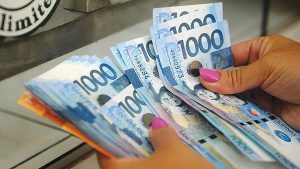Bloomberg
The Philippine peso may extend its record-setting slump against the greenback as billions of dollars of trade deficits weigh on the currency, increasing pressure on the central bank to intervene to slow its descent.
The peso may slide to an all-time low of about 62 against the dollar as early as this year, about 4.8% weaker than Monday’s close, according to ING Groep NV, Bank of the Philippine Islands and eMBM Services. The currency has slumped more than 13% this year, and is one of the worst-performers in Asia.
Policy makers across Asia’s emerging markets are dipping in to their foreign-exchange stockpiles and ramping up verbal warnings against speculators as rate hikes by the Federal Reserve drive the dollar higher. Bangko Sentral ng Pilipinas has signaled it may need to take stronger measures to stem peso losses, including draining liquidity and boosting borrowing costs.
“The peso is feeling the heat,†said Nicholas Mapa, senior economist at ING in Manila. “Surging imports are boosting demand for dollars and leading to elevated trade deficits. The central bank is likely in the market to smooth out volatility, but you can’t really do much when the Fed comes in hot and heavy.â€
The Southeast Asian nation’s monthly trade deficit exceeded $5 billion for four consecutive months through July, as imports climbed. Rising imports prompted officials to increase the forecast for the nation’s current-account gap to a record $20.6 billion this year.
“The peso can hit 60 by early November if US data remain strong and BSP refrains from an off-cycle hike,†said Emilio Neri, lead economist at Bank of the Philippine Islands in Manila, adding that the peso could then go on to test the
62-per-dollar level.
The views from ING and BPI lean on the bearish side in terms of market forecast for the peso. The currency will likely end both this year and the first quarter of 2023 at 57, according to the median forecast in a Bloomberg survey.
About half of the estimates in the survey, however, were submitted before the slide in the currency accelerated in the second half of September.
Inflation data due this week will help determine the need for more aggressive interest-rate hikes after the central bank delivered 2.25 percentage points of increases this year. BSP is scheduled to next decide on policy in November.
Foreign selling of Philippine equities as the benchmark sank into bear-market territory is also adding to pressure on the currency. Outflows have reached $1.2 billion this year.
 The Gulf Time Newspaper One of the finest business newspapers in the UAE brought to you by our professional writers and editors.
The Gulf Time Newspaper One of the finest business newspapers in the UAE brought to you by our professional writers and editors.
